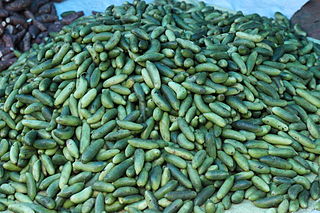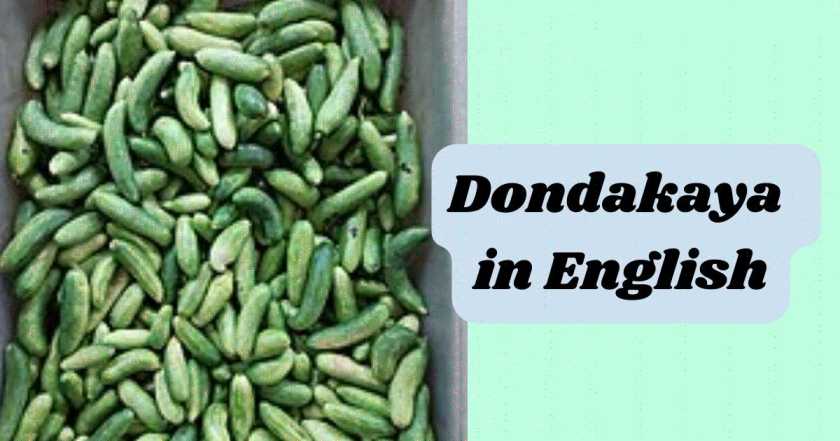Dondakaya in English
- Dondakaya in English Name is “Ivy Gourd“
Dondakaya in Hindi
- Dondakaya in Hindi is “Tindora“
Dondakaya in Tamil
- Dondakaya in Tamil is “Kovakkai“

Dondakaya (Ivy Gourd)
Dondakaya, also known as Ivy Gourd in English, is a versatile vegetable that has gained popularity in various cuisines around the world. Its unique flavor and nutritional benefits make it a favorite ingredient in many dishes. This humble vegetable has a lot to offer, from its crunchy texture to its ability to absorb flavors in cooking.
Dondakaya, known as “Tindora” in Hindi, is referred to as “Kovakkai” in Tamil.
The historical roots of Dondakaya, also known as Ivy Gourd, can be traced back to ancient times, where it was a staple in traditional cuisines across different regions. This versatile vegetable has a rich history, with its origins believed to be in the Indian subcontinent. In India, Dondakaya holds cultural significance and is a beloved ingredient in various regional dishes, such as curries, stir-fries, and chutneys.
Beyond India, Dondakaya has made its way into the culinary traditions of Southeast Asia, particularly in countries like Thailand, Indonesia, and the Philippines. In these regions, it is commonly used in spicy stir-fries and soups, adding a unique flavor and texture to the dishes. Additionally, Dondakaya has found its place in Caribbean and African cuisines, where it is incorporated into stews and side dishes.
The cultural significance of Dondakaya extends beyond its culinary uses. In many cultures, this vegetable is associated with health and well-being, believed to possess medicinal properties that aid in digestion and promote overall health. Its presence in traditional medicine practices highlights its importance not just as a food ingredient but also as a natural remedy.
Overall, the origins and cultural significance of Dondakaya reflect its journey from being a local ingredient to a global culinary gem. Its ability to adapt to different cooking styles and flavor profiles has made it a cherished component in diverse cuisines, showcasing the rich tapestry of flavors and traditions that define our culinary landscape.
Dondakaya Benefits
Health benefits associated with consuming Dondakaya are plentiful and contribute to its reputation as a nutritious vegetable.
- One of the key advantages of incorporating Dondakaya into your diet is its high fiber content. Fiber plays a crucial role in digestive health by promoting regular bowel movements and preventing constipation.
- Additionally, the fiber in Dondakaya can help regulate blood sugar levels, making it a valuable addition for individuals managing diabetes or looking to improve their overall glycemic control.
- Another notable benefit of Dondakaya is its rich vitamin and mineral profile. This vegetable is a good source of essential nutrients such as vitamin C, vitamin A, and potassium. Vitamin C is known for its immune-boosting properties and its role in collagen production, which is essential for skin health. Vitamin A supports vision, immune function, and skin health, while potassium helps regulate blood pressure and maintain proper muscle function.
- Moreover, Dondakaya is a low-calorie vegetable, making it a great option for individuals looking to manage their weight or incorporate more nutrient-dense foods into their meals. Its low-calorie content combined with its high fiber and water content can help promote feelings of fullness and satiety, which may aid in weight management efforts.
- In addition to its nutritional benefits, Dondakaya is also rich in antioxidants, which help protect the body against oxidative stress and inflammation. These antioxidants play a role in reducing the risk of chronic diseases such as heart disease, cancer, and neurodegenerative disorders.
Overall, the health benefits of consuming Dondakaya make it a valuable addition to a balanced diet. Whether you enjoy it in curries, stir-fries, or salads, incorporating this versatile vegetable into your meals can provide a range of nutrients that support overall health and well-being.
Dondakaya in Traditional Medicine
Exploring the traditional medicinal uses of Dondakaya reveals a rich history of this versatile vegetable being utilized for its health benefits. In traditional medicine practices, Dondakaya has been valued for its ability to aid in digestion, regulate blood sugar levels, and promote overall well-being. The vegetable is often incorporated into herbal remedies and tonics to address various health concerns.
Moreover, modern scientific research has shed light on the health benefits of Dondakaya, corroborating its traditional uses. Studies have shown that Dondakaya is a good source of essential nutrients, antioxidants, and dietary fiber, which are beneficial for digestive health and immune function. Additionally, the vegetable contains bioactive compounds that exhibit anti-inflammatory and anti-diabetic properties, further supporting its role in traditional medicine.
The combination of traditional wisdom and scientific evidence underscores the holistic approach to health that Dondakaya offers. By incorporating this nutrient-rich vegetable into diet and wellness routines, individuals can harness its medicinal properties to support their overall health and well-being. Whether consumed raw, cooked, or as a supplement, Dondakaya continues to be a valuable ingredient in traditional medicine practices and modern health-conscious lifestyles.
Culinary Uses
When it comes to culinary uses, Dondakaya, also known as Ivy Gourd, offers a versatile and flavorful addition to various dishes. In cooking, Dondakaya is prized for its ability to absorb flavors while maintaining a slightly crunchy texture, adding a unique element to recipes.
One of the most common ways to prepare Dondakaya is through stir-frying. This method involves quickly cooking the vegetable in a hot pan with a mix of spices, herbs, and sometimes other vegetables. Stir-fried Dondakaya pairs well with rice or roti, making it a popular choice for a quick and nutritious meal.
Curries are another popular way to incorporate Dondakaya into Indian cuisine. The vegetable’s mild flavor allows it to absorb the rich and aromatic spices commonly used in curries, creating a delicious and satisfying dish. Dondakaya curry can be enjoyed with rice or bread, adding a burst of flavor to the meal.
In addition to stir-fries and curries, Dondakaya is also commonly used in pickling. The tangy and spicy flavors of pickled Dondakaya make it a popular accompaniment to meals, adding a zesty kick to the palate. Pickled Dondakaya can be enjoyed as a side dish or added to sandwiches and wraps for an extra punch of flavor.
For those looking to explore new culinary horizons, there are numerous popular recipes featuring Dondakaya. From Dondakaya masala to stuffed Dondakaya, the possibilities are endless. Whether you prefer traditional recipes or modern twists, Dondakaya’s versatility in the kitchen makes it a delightful ingredient to work with.
Tips for Selecting and Storing
When it comes to selecting Dondakaya at the market, look for firm and unblemished gourds with vibrant green skin. Avoid any that appear soft or have dark spots, as these may indicate spoilage. Opt for smaller-sized Dondakaya, as they tend to be more tender and flavorful. Additionally, check the stem end of the gourd – a fresh Dondakaya will have a green stem without any signs of drying or wilting.
To ensure your Dondakaya stays fresh for longer, store them in a perforated plastic bag in the refrigerator’s vegetable crisper drawer. This will help maintain the gourd’s moisture levels while allowing for proper air circulation. Avoid washing Dondakaya before storing, as excess moisture can lead to premature spoilage. If you’ve already cut into a Dondakaya, wrap the remaining pieces tightly in plastic wrap and refrigerate them for up to a few days.
Growing Dondakaya
To successfully grow Dondakaya in your home garden, start by selecting a sunny spot with well-draining soil. These gourds thrive in warm climates, so ensure they receive plenty of sunlight throughout the day. Begin by planting Dondakaya seeds or seedlings in the soil, spacing them adequately to allow for proper growth.
When cultivating Dondakaya plants, it’s essential to provide consistent watering, especially during dry periods. Mulching around the base of the plants can help retain moisture and suppress weed growth. Additionally, consider using a trellis or support system to encourage vertical growth and prevent the vines from sprawling.
Regularly inspect the plants for pests and diseases, addressing any issues promptly to ensure healthy growth. Pruning the vines can also promote better air circulation and fruit development. As the Dondakaya gourds mature, harvest them while they are still young and tender for the best flavor and texture.







